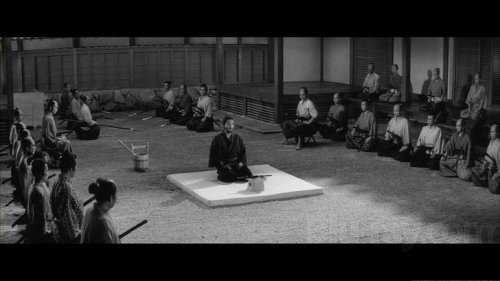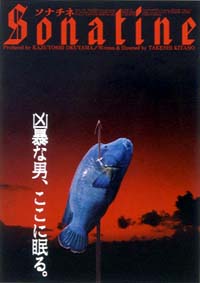I think there are more horrid specimens in the film. For instance, the high ranking official Zushiô goes to to plead his case. When the man turns and saunters down the walkway followed by his servants, and there's that long white sash hanging out the back end of his trousers, (seriously, didn't you think he'd gone to the bathroom and forgotten something?) He walks coldly past Zushiô, completely ignoring his desperation---only when they discover noble lineage on his person, in the form a tiny statuette, do they grant him an audience, simply because he's one of them. These guys are the bigger rotters: they are plugged into the system and profit enormously from it, and yet are so refined and removed from it all, as to appear like benevolent philanthropists, bestowing pardons and restoring prestige with a wave of the hand. Also when Zushiô gets his reward, he finds out it's only largely ceremonial with no power but plenty of prestige.
Indeed. Speaking about profitting from the system, when one of the governors visited Sansho's place, he marvelled at Sansho's productivity and praised his methods to achieve that level of productivity. He reaches to the treasures beside him, ignoring the dance put up by the slave dancers. I can only assume that he, like the other governors, were unaware of the cruelties of slavery.
That's also one of the interesting things about the film ... the name. The eponymous Sansho is in reality, only a minor character. He'd be what we would call today, middle management, he only runs this compound for someone much wealthier. Perhaps the film is suggesting he's a kind of surrogate father to the boy?
I dont think that is the case. It would be more fitting to use Sansho for the title as Sansho, in my opinion, is the tyrant who directly manipulates the slaves and gives the orders to punish them. Like I said, I think the government officials were simply apathetic to the plight of the slaves. So long as the Bailiffs produce and produce results, then the Governors wouldnt have probed further.
If we look at it from a different perspective, maybe the true "evil" in this film is neither Sansho nor the government officials. You can say that they were merely carrying out their duty in the name of this system. Perhaps the actual evil people were the
villagers who sold the mother and children to slavery. Remember that slavery was common only for homeless peasants. The woman who betrayed them early in the film is motivated by profit. Even the lower class is embroiled in this dirty game.
Taro is struck to the core by these simple words. Any kind of revolt in the compound is severely punished---that there's an alternative to that world is a revelation for him. Buoyed by that precept, he'll leave that night and plead Zushiô's case to the royal court (falling on deaf ears and failing that, he runs away to become a priest). A few moments later, Taro appears in the main hall,
I dont think he could leave for good. I mean, Sansho is his father. He had to return.
Not long afterwards, a pit boss orders Zushiô to get rid of an old dying woman. They literally dump them on the ground like slabs of meat. But Anju accompanies him into the forest outside the locked gates and asks the guard if she can build a little shelter for the old woman. Which causes them to repeat and recall a similar incident from childhood where they also built a shelter that spurs on their escape. Instead of Anju, he takes the old woman---symbolically rescuing their mother.
Interesting... Why do you think Anju committed suicide when it is quite apparent that she could escape? It's surprising because you would not expect that from someone who remembered her father's words and stayed strong after all those years, even correcting Zushio of his ways from time to time.
 I've been avoiding that for a long time. I tend to prefer the classic Japanese directors to the radical Japanese New Wave directors like Oshima, Immamura and Suzuki.
I've been avoiding that for a long time. I tend to prefer the classic Japanese directors to the radical Japanese New Wave directors like Oshima, Immamura and Suzuki.
 I've been avoiding that for a long time. I tend to prefer the classic Japanese directors to the radical Japanese New Wave directors like Oshima, Immamura and Suzuki.
I've been avoiding that for a long time. I tend to prefer the classic Japanese directors to the radical Japanese New Wave directors like Oshima, Immamura and Suzuki.







